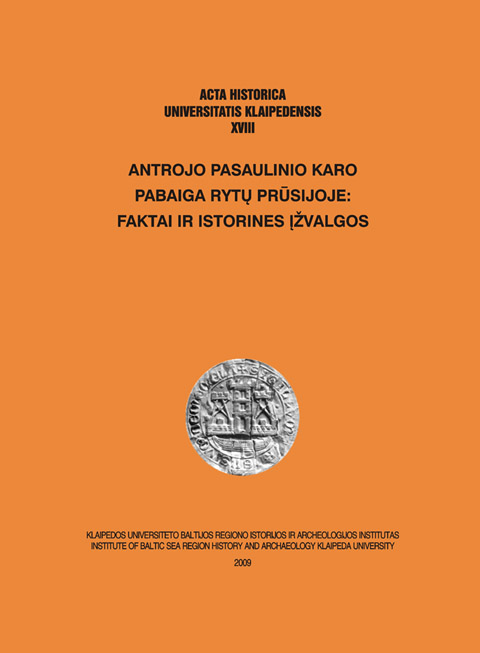Volume 18 (2009): Antrojo pasaulinio karo pabaiga Rytų Prūsijoje: faktai ir istorinės įžvalgos = End of the Second World War in East Prussia: Facts and Historical Perception, September 2009

Order by:
Pub. online: 8 Sep 2009
Type: Introduction
 Open Access
Open Access
Journal:
Acta Historica Universitatis Klaipedensis
Volume 18 (2009): Antrojo pasaulinio karo pabaiga Rytų Prūsijoje: faktai ir istorinės įžvalgos = End of the Second World War in East Prussia: Facts and Historical Perception, pp. 5–6
Pub. online: 8 Sep 2009
Type: Article
 Open Access
Open Access
Journal:
Acta Historica Universitatis Klaipedensis
Volume 18 (2009): Antrojo pasaulinio karo pabaiga Rytų Prūsijoje: faktai ir istorinės įžvalgos = End of the Second World War in East Prussia: Facts and Historical Perception, pp. 7–29
Abstract
Pub. online: 8 Sep 2009
Type: Article
 Open Access
Open Access
Journal:
Acta Historica Universitatis Klaipedensis
Volume 18 (2009): Antrojo pasaulinio karo pabaiga Rytų Prūsijoje: faktai ir istorinės įžvalgos = End of the Second World War in East Prussia: Facts and Historical Perception, pp. 30–56
Abstract
Pub. online: 8 Sep 2009
Type: Article
 Open Access
Open Access
Journal:
Acta Historica Universitatis Klaipedensis
Volume 18 (2009): Antrojo pasaulinio karo pabaiga Rytų Prūsijoje: faktai ir istorinės įžvalgos = End of the Second World War in East Prussia: Facts and Historical Perception, pp. 57–70
Abstract
Pub. online: 8 Sep 2009
Type: Article
 Open Access
Open Access
Journal:
Acta Historica Universitatis Klaipedensis
Volume 18 (2009): Antrojo pasaulinio karo pabaiga Rytų Prūsijoje: faktai ir istorinės įžvalgos = End of the Second World War in East Prussia: Facts and Historical Perception, pp. 71–86
Abstract
Pub. online: 8 Sep 2009
Type: Article
 Open Access
Open Access
Journal:
Acta Historica Universitatis Klaipedensis
Volume 18 (2009): Antrojo pasaulinio karo pabaiga Rytų Prūsijoje: faktai ir istorinės įžvalgos = End of the Second World War in East Prussia: Facts and Historical Perception, pp. 87–108
Abstract
Pub. online: 8 Sep 2009
Type: Article
 Open Access
Open Access
Journal:
Acta Historica Universitatis Klaipedensis
Volume 18 (2009): Antrojo pasaulinio karo pabaiga Rytų Prūsijoje: faktai ir istorinės įžvalgos = End of the Second World War in East Prussia: Facts and Historical Perception, pp. 109–126
Abstract
Pub. online: 8 Sep 2009
Type: Article
 Open Access
Open Access
Journal:
Acta Historica Universitatis Klaipedensis
Volume 18 (2009): Antrojo pasaulinio karo pabaiga Rytų Prūsijoje: faktai ir istorinės įžvalgos = End of the Second World War in East Prussia: Facts and Historical Perception, pp. 127–150
Abstract
Pub. online: 8 Sep 2009
Type: Article
 Open Access
Open Access
Journal:
Acta Historica Universitatis Klaipedensis
Volume 18 (2009): Antrojo pasaulinio karo pabaiga Rytų Prūsijoje: faktai ir istorinės įžvalgos = End of the Second World War in East Prussia: Facts and Historical Perception, pp. 151–159
Abstract
Pub. online: 8 Sep 2009
Type: Article
 Open Access
Open Access
Journal:
Acta Historica Universitatis Klaipedensis
Volume 18 (2009): Antrojo pasaulinio karo pabaiga Rytų Prūsijoje: faktai ir istorinės įžvalgos = End of the Second World War in East Prussia: Facts and Historical Perception, pp. 160–188
Abstract